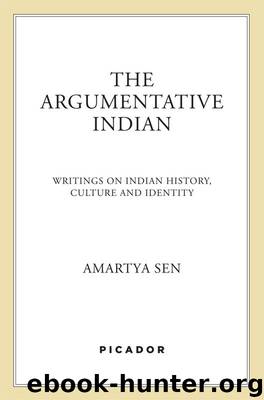The Argumentative Indian: Writings on Indian History, Culture and Identity by Amartya Sen

Author:Amartya Sen [Sen, Amartya]
Language: eng
Format: epub, mobi, azw3
Tags: Non-Fiction, History, Philosophy, Writing, Sociology
ISBN: 9780312426026
Amazon: 031242602X
Barnesnoble: 031242602X
Goodreads: 10310
Publisher: Farrar, Straus and Giroux
Published: 2013-10-15T00:00:00+00:00
11
Women and Men*
Many Faces of Gender Inequality
Inequality between women and men can appear in many different forms – it has many faces.1 Gender disparity is, in fact, not one affliction but a multitude of problems. Sometimes the different asymmetries are quite unrelated to each other. Indeed, there may be no significant inequality in one sphere but a great deal of inequality in another. For example, Japan has no particular gender bias in nutrition or health care or school education, but men do seem to have considerable relative advantage in securing high leadership positions in administration or business.
However, in other cases, gender inequality of one type tends to encourage and sustain gender inequality of other kinds. Consequential analysis can then be critically important even within the large corpus of gender relations in general, in order to examine and scrutinize how the different aspects of gender inequality relate to each other. For while gender inequality has many faces, these are not independent (like those in the austere image of Brahma in early Indian iconography). Rather, they speak to each other and sometimes strongly encourage one another. For example, when women lack decisional power within the family, which amounts to a deprivation of women’s effective agency, this can also adversely affect their own well-being. The two kinds of deprivation may not only move together – be ‘covariant’ – but they may be linked with each other through causal connections.
Well-being and Agency
It is useful to relate the topic of this essay to the general distinction between two features of human life, to wit, ‘well-being’ and ‘agency’, which I have explored elsewhere.2 This distinction corresponds to the old dichotomy, much used in medieval European literature, between ‘the patient’ and ‘the agent’. The distinction is not only important in itself, it also has a very substantial bearing on the causal connections related to gender relations.*
The agency aspect refers to the pursuit of goals and objectives that a person has reason to value and advance, whether or not they are connected with the person’s own well-being. People may actively choose to pursue other objectives (that is, other than personal well-being), which could, quite possibly, be very broad, such as independence of one’s country, the elimination of famines and epidemics, or (related to the present context) the removal of gender inequality in general. Even though there may be some overlap between different objectives, nevertheless as a general rule in championing these broader ends people may not be primarily influenced by the extent to which these general objectives affect their own quality of life or welfare.
The distinction between ‘agency’ and ‘well-being’ is conceptually rich, since they refer to two distinct ways in which a person’s values, ends, ambitions, freedoms and achievements can be understood, using two different perspectives of assessment. As it happens, the distinction is of substantial relevance, in general, in interpreting practical policies and activities, and, in particular, in understanding the priorities of social movements, including the increasingly powerful ‘women’s movements’ in many parts of the world.
Indeed,
Download
The Argumentative Indian: Writings on Indian History, Culture and Identity by Amartya Sen.epub
The Argumentative Indian: Writings on Indian History, Culture and Identity by Amartya Sen.mobi
The Argumentative Indian: Writings on Indian History, Culture and Identity by Amartya Sen.azw3
This site does not store any files on its server. We only index and link to content provided by other sites. Please contact the content providers to delete copyright contents if any and email us, we'll remove relevant links or contents immediately.
| African-American Studies | Asian American Studies |
| Disabled | Ethnic Studies |
| Hispanic American Studies | LGBT |
| Minority Studies | Native American Studies |
Cecilia; Or, Memoirs of an Heiress — Volume 1 by Fanny Burney(32434)
Cecilia; Or, Memoirs of an Heiress — Volume 2 by Fanny Burney(31871)
Cecilia; Or, Memoirs of an Heiress — Volume 3 by Fanny Burney(31854)
The Great Music City by Andrea Baker(31357)
We're Going to Need More Wine by Gabrielle Union(18967)
All the Missing Girls by Megan Miranda(15573)
Pimp by Iceberg Slim(14394)
Bombshells: Glamour Girls of a Lifetime by Sullivan Steve(13975)
Talking to Strangers by Malcolm Gladwell(13222)
Norse Mythology by Gaiman Neil(13207)
Fifty Shades Freed by E L James(13157)
For the Love of Europe by Rick Steves(13000)
Mindhunter: Inside the FBI's Elite Serial Crime Unit by John E. Douglas & Mark Olshaker(9201)
Crazy Rich Asians by Kevin Kwan(9167)
The Lost Art of Listening by Michael P. Nichols(7407)
Enlightenment Now: The Case for Reason, Science, Humanism, and Progress by Steven Pinker(7235)
The Four Agreements by Don Miguel Ruiz(6632)
Bad Blood by John Carreyrou(6552)
Weapons of Math Destruction by Cathy O'Neil(6146)
